The ATi Rage graphics accelerators saw ATi, which is now owned by AMD, rise over a four-year period to become one of the key graphics hardware manufacturers. Its products didn’t break new ground like those of 3dfx and Nvidia in the same period, but they consistently delivered the latest 3D features in products that more of us could afford.
The first Rage 3D products were typical of early 2D/3D graphics chips. Keen to jump on the 3D bandwagon as buzz grew around the first 3dfx and VideoLogic 3D-only cards, ATi combined the 2D Windows accelerator tech behind its popular Mach64 chips with 3D tech it picked up from acquiring the design team from Kubota Graphics. This was a small division of an industrial and construction giant, specializing in high-end graphics workstations.
The new chip was launched at the Comdex trade show in the winter of 1995, and was originally going to be called the 264GT. However, at the last minute, Product Manager Phil Eisler caught wind that S3 was planning to announce its own 2D/3D accelerator, the S3 ViRGE, which clearly had a cooler name. Eisler hijacked the Rage branding from an arcade graphics board on which ATi was working, and the ATi 3D Rage was born.
Launched in early 1996, the 3D Rage, the S3 ViRGE and new Matrox Mystique cards were all sold at a price not much higher than you (or a PC manufacturer) would pay for a standard 2D graphics card. That was a big deal when 3D-only cards cost upwards of $200. Pundits described the new cards as ‘Free-D’.
Of course, you got what you paid for. All these early 3D cards were basic, with a single pixel shader, one texture-mapping unit (TMU) and one raster operations pipeline (ROP). The more powerful, two-processor design of the 3dfx Voodoo, which also handled the depth-buffering and shading, left them in the dust. What’s more, where 3dfx had its own GLide API – and developer support from the likes of id Software – ATi was designed to accelerate Microsoft’s Direct 3D, which Microsoft hadn’t even finished at the time of launch.
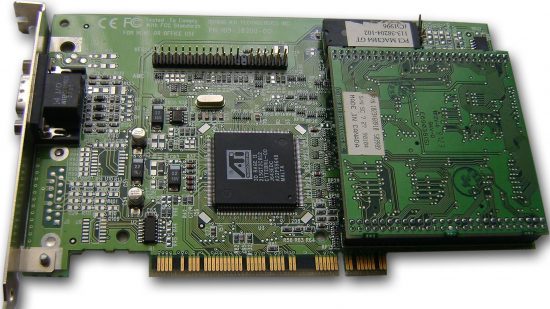
The 3D Rage and 3D Rage II were typical ‘Free-D’ chips, with decent 2D and video performance but only basic 3D. Photo credit: Toggomusic, CC-by-SA 3.0
While the 3D Rage was successful, it wasn’t a great 3D graphics accelerator. The titles that ran best were those designed or ported to run on ATi’s tech, while issues with the depth buffer, blending operations and mipmapping meant that many early Direct3D titles ran at poor frame rates or with visual artifacts – or simply didn’t run at all.
ATi’s follow-ups, the Rage II and Rage II+, improved speeds and fixed bugs but didn’t give 3dfx much in the way of competition. If ATi wanted to stay in the game, it needed to get serious about 3D.
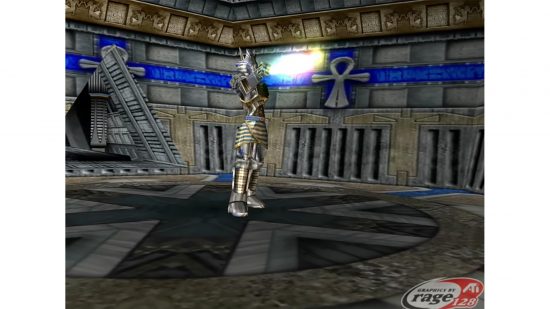
ATi showcased the power of the Rage 128 with the ATi Rage Dawning demo. The people who codes these demos loved reflections and glowing light a little too much
Going pro
That’s just what it did. Launched in 1997, the ATi Rage Pro had several advantages over the Rage II+, promising a 3x improvement in 3D performance. The big one was that this was the first ATi chip with a built-in, floating-point setup engine, capable of processing up to 1.2 million triangles per second.
This took work from the CPU and accelerated it, meaning the CPU could focus on core 3D geometry and lighting transformations. The Rage Pro also included enhanced support for alpha-blending features, such as fog and transparency effects, along with specular lighting, single-pass trilinear filtering and texture compression.
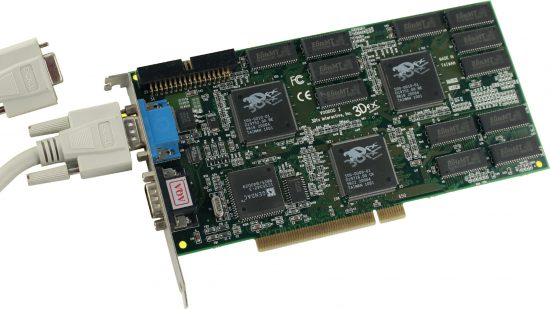
Just as crucially, the Rage Pro brought benefits beyond the chip itself. It was the first ATi chip to fully support the Intel AGP (Accelerated Graphics Port) interface, which dramatically improved read/write speeds between the graphics card and the motherboard chipset, and through that to the CPU and system RAM. You could actually read textures directly from RAM without killing performance. It was also the first ATi graphics card to use 100MHz SGRAM, giving you much faster video memory on-board.
Sadly, ATi still had a problem. While the Rage Pro was a significantly better 3D accelerator, the competition was moving even faster. The Nvidia Riva TNT featured two texture mapping engines for speeds that rivaled the mighty 3dfx Voodoo2 (pictured above). Even though the TNT didn’t have the Rage Pro’s triangle setup engine, the Rage Pro fell behind it in both Direct 3D and Quake II benchmarks, with the Nvidia cards sometimes doubling frame rates. ATi risked looking like an also-ran. It needed to take itself up another level.
Taking on the Nvidia Riva TNT
Launched at the end of 1998, the ATi Rage 128 seemed hell-bent on one purpose: destroying the Riva TNT. It helped that it was the first Rage chip to be fabricated on a new process, with ATi moving from 350nm to 250nm tech. In theory, this meant the Rage 128 could be run at higher clock speeds without overheating.
ATi also added both a pixel cache and a texture cache to improve efficiency, and followed Nvidia in implementing single-pass multi-texturing, with dual texture-mapping pipelines that enabled Rage 128 to render two bilinear filtered pixels, or one bump-mapped pixel, per clock.
Bump mapping itself was seen as a major new feature, enabling games to render more realistic surfaces with the impression of relief, although only a few showcase games, such as Rage Software’s Expendable, actually used it. Perhaps the biggest plus with the Rage 128, however, was that it was the first 3D chip to operate in 32-bit color without a huge performance penalty – less than 10 percent against the TNT’s 40 percent.
Neither the existing 3dfx Voodoo2 nor the upcoming Voodoo3 even supported 32-bit 3D, and at a time when more games were coming out with 32-bit color options, and with a noticeable visual difference, this was a real feather in ATi’s cap.
Embarrassingly, though, as with the Riva TNT before it, clock speeds had to be reduced before launch to avoid overheating, with the first cards launching at 90MHz rather than 100MHz. Worse, delays getting into stores meant the Rage 128 came up against the new Nvidia Riva TNT2 and 3dfx Voodoo3 chips within months of launch.
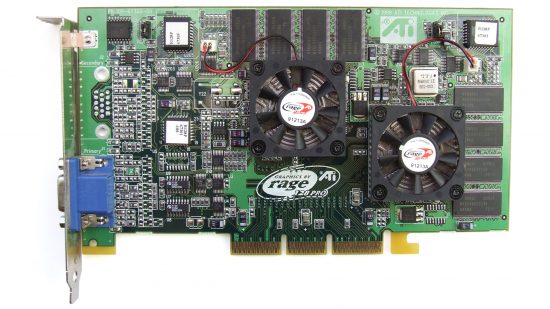
The ATi Rage Fury Maxx gave you two Rage 128 Pro chips on a single card, rendering alternate frames. Photo credit: Trio 3D, CC-By-SA 3.0
Still, it did enough. Benchmarks showed similar and sometimes better performance than the TNT and Voodoo2, while the chip’s triangle setup engine meant performance remained steady when partnered with lower-end CPUs. The Rage 128 was the best card out there if you moved to 32-bit color, although issues with Super Socket 7 chipsets made it a non-starter if you rocked an AMD or Cyrix CPU.
The Rage 128 was inevitably followed one year later by the Rage 128 Pro, with an enhanced triangle setup engine and higher clock speeds, plus the ATi Rage Fury MAXX, which incorporated two Rage 128 Pro chips, rendering alternate frames. Both helped ATi to remain competitive as the graphics hardware industry evolved, but struggled against the Nvidia GeForce 256 with its hardware transform and lighting acceleration.
Sometimes, that’s enough. ATi’s investment in 3D tech kept it in the picture at a time when other graphics hardware companies were beginning to find the costs too high and the competition too hot. Aggressive pricing helped, while ATi continued to win big OEM contracts from the likes of Compaq and Apple.
Throughout the Rage line’s lifespan, ATi also created different variants to reach different areas of the market. ATi capitalized on its strength in video and DVD decoding through its ATi All-in-Wonder line, which combined Rage II+, Rage Pro or Rage 128 processors with a TV tuner and composite and S-Video outputs.
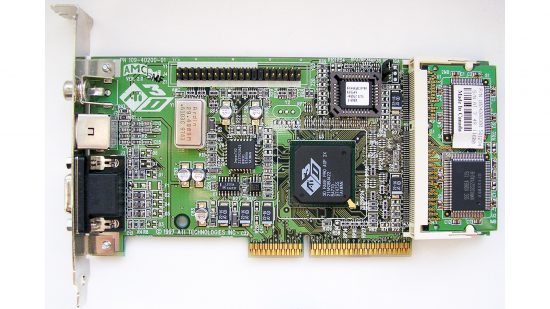
ATi released the Rage Pro in two cards. The only difference? The Xpert@Play (above) had an S-Video output for your TV. Photo credit: Own work by Gona.eu, CC-BY-SA 3.0
The Rage Pro, meanwhile, was initially sold in two formats, as the ATi Xpert@Work, aimed at business users, and ATi Xpert@Play, aimed more at gamers. The only difference between the two was that the latter had an S-Video output as well as VGA.
As time went on, the company followed the lead of Nvidia and 3dfx in building closer relationships with games developers, and its Rage tech provided a solid platform on which it could build, with the Rage 6 chip that was to succeed the 128 Pro morphing into the first ATi Radeon GPU. As the list of contenders became ever smaller, ATi remained in the game.
Fast forward to the present day, and the AMD GPU division, which started life as ATi, is still going strong. If you’re looking to upgrade to the latest Nvidia or AMD GPU, make sure you read our full guide to the best graphics card, which covers the best options at a range of prices. One of our current favorites from the company that bought ATi is the new AMD Radeon RX 7900 XTX, which offers amazing 4K gaming performance for under $1,000.
We hope you’ve enjoyed finding out about the roots of the AMD Radeon GPU division. For more articles about the PC’s vintage history, check out our Retro tech page, and if you love a bit of 3dfx nostalgia, take a look at this recreation of the never-released 3dfx Voodoo5 6000.